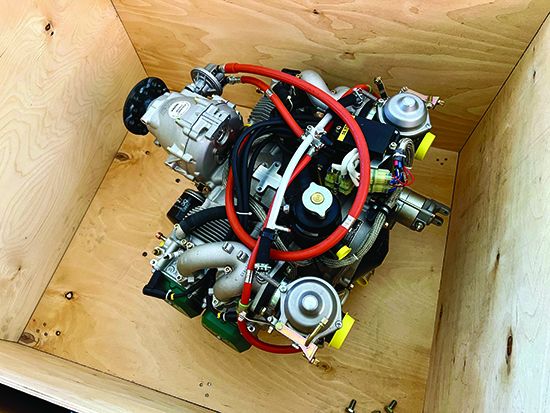The little zero-time Rotax 912, pictured lower left, is eventually going on our Van’s RV-12 E-LSA. And while it’s been stored (for five years) in its original shipping crate and its insides haven’t been exposed to outside air, it’s we’ll past its storage shelf life and certainly outside of the Rotax factory warranty. For others building aircraft from kits, major components—including expensive engines—sit in non-climate-controlled environments exposed to wide temperature and humidity extremes, while the warranty clock expires long before the aircraft sees the light of day. In the world of aircraft engine warranties, that could be considered misuse. We took a look at the basic manufacturer’s warranty for common engines and we think owners should, too, especially before sourcing one that will sit.
Before digging into specific warranty items, a few words on new engine deliveries and prices. We’re preparing an engine satisfaction survey for an upcoming field report in Aviation Consumer, but even without the hard data, we’re sensing a market in turmoil with buyers screaming about huge price increases and worried about long delivery times after dropping big deposits for new engines, including so-called boutique engines from smaller specialty shops. “Stuck waiting for a Lycoming IO-540 we ordered over 18 months ago for our RV-10 project, it’s a little scary having dropped a $45,000 deposit and still have no estimated delivery,” reader Bobby Hubbard told us a few months ago. Some buyers fear that smaller engine dealers might not get the same delivery priority as higher-volume ones. That hurts cash flow—which may already be running lean—and threatens the health and longevity of the dealership. It’s an even slippier slope when the business has collected deposit money.
So once you do finally take delivery of the engine, how long can you let it sit in preservation before the warranty clock starts running? It varies, but you should specifically ask. Continental has a six-month preservation period. When you’re ready to run, Continental’s warranty says that the warranty activation date is the date the engine is first operated for any use, or the 180th day after the Continental billing invoice date, whichever occurs first. Lycoming’s limited warranty says it commences on either the date the new (and rebuilt) engine is first operated or used for any purpose, or 24 months after the new and rebuilt engine shipped from Lycoming, whichever occurs first.
Recognizing that engines don’t like to sit, you might get more warranty time out of a Lycoming engine that’s so-called “highly utilized.” For example, Lycoming warrants the crankcase, crankshaft, cylinders, sump, accessory housing and all internally lubricated parts to be free from defects in material or workmanship under normal use and service for an additional 12-month period on highly utilized engines that consistently accumulate 40 or more flight hours per month. Otherwise, the warranty covers defects in material and workmanship for a period of either 24 months or the recommended time (in engine hours) between overhauls (TBO), whichever occurs first. A repair or replacement is provided at the company’s option. But there is also labor involved.
Continental says it will pay for labor costs associated with repairs or replacements in accordance with the latest revision of the warranty labor allowance schedule that’s published on its website. Many shops post labor rates in excess of $125—not unreasonable, in our view. “Reasonable troubleshooting costs will be allowed, but in no event will the troubleshooting costs exceed 15 percent of the labor costs associated with repairs or replacements,” it says. Troubleshooting costs will not be allowed when the need for repair or replacement is identified in the course of an overhaul or routine maintenance, or on the basis of an obvious defect. Lycoming says it will reimburse the labor costs listed by the latest edition of Lycoming’s Removal and Installation Labor and Allowance Guidebook. You might end up paying extra.
What about accessories? There are guidelines. Continental, for example, says it warrants any accessory that Continental purchased from an accessory manufacturer as a complete and finished unit and included in the assembly of an engine (without anyone altering the unit) including, but not limited to, carburetors, starters, alternators, turbochargers and fuel controls for 12 months. After that time period, the original accessory manufacturer may or may not step up.
Don’t underestimate skyrocketing freight costs. Continental reimburses up to $500, and Lycoming pays what it calls “standard freight charges” and says expedited freight charges must be authorized in advance.
Last, we advise that any shop performing warranty work contact the engine manufacturer before even turning a wrench (diagnostics generally aren’t covered) as we’ve seen warranty claims denied because the troubleshooting effort went in the wrong direction.
—Larry Anglisano





